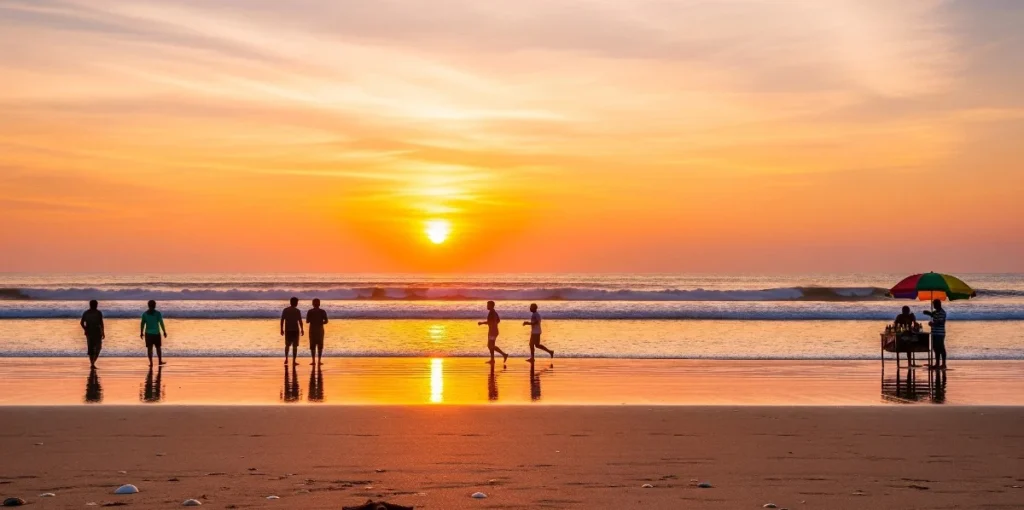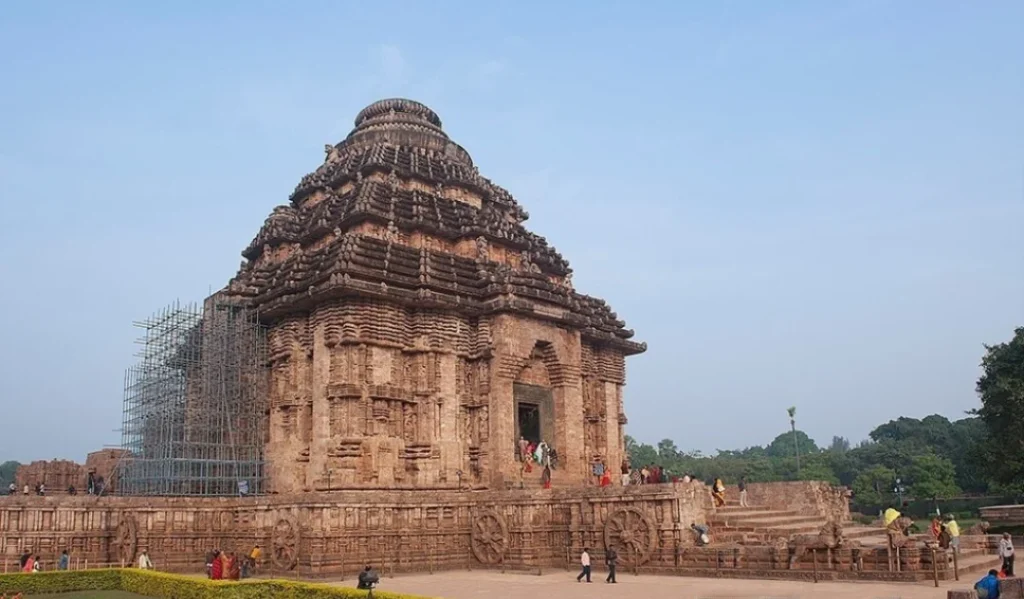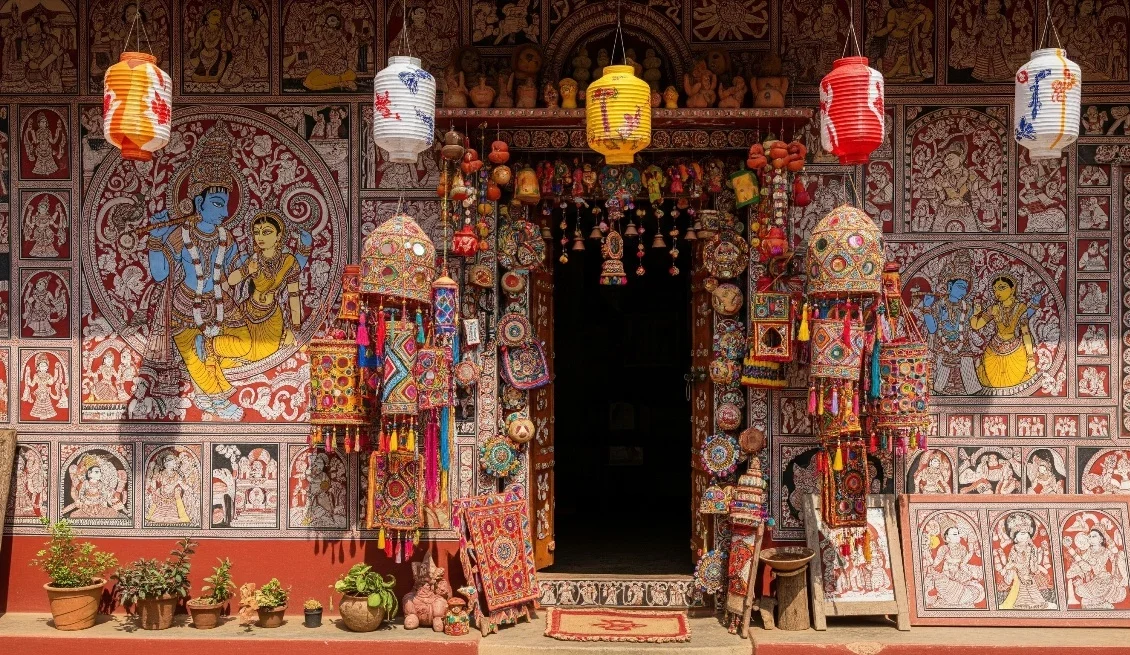When people think of Puri, the first image that comes to mind is the towering Jagannath Temple, one of the Char Dham pilgrimage sites. But settled quietly inside the temple complex lies a shrine that is often overlooked yet holds equal – if not greater – spiritual significance: the Vimala Temple, Puri.
For centuries, devotees have believed that a pilgrimage to Jagannath Temple remains incomplete without paying respects at Vimala Temple. Here, amidst the chants and the timeless aura of Puri, I discovered not just history and mythology but also an intimate sense of divine protection.
Mythology of Vimala Temple, Puri
According to the Hindu Puranas, Sati, the daughter of Prajapati Daksha, married Shiva against her father’s wishes. Daksha performed a grand yajna (sacrifice) but did not invite Sati or Shiva. Even so, Sati went to the yajna, where Daksha ignored her and insulted Shiva. Unable to bear the insult, Sati offered herself into the fire. Filled with grief, Shiva wandered the universe carrying her half-burnt body. At last, Vishnu used his Sudarshan Chakra to cut her body into 51 parts, which fell on different places across the earth. Each of these places became a Shakti Peeth.
The Vimala Temple is one of the Adi Shakti Peethas. Legend says (Pithanirnaya or Mahapithanirupana section from the Tantrachudamani) Sati’s navel fell here. It makes Puri as one of the four Adi Shaktipeethas alongside Tara Tarini, Kamakhya and Kalighat.
Interestingly, despite being a Shakti shrine, Vimala Temple is inseparable from Jagannath culture. Every offering made to Lord Jagannath is considered incomplete until a portion is first presented to Goddess Vimala. This intertwining of Vaishnavism and Shaktism makes Puri unique – it’s not just about Vishnu or Shiva but the balance of divine feminine and masculine energies.
Historical Background
Madala Panji states that Yayati Keshari, a ruler of the Somavanshi Dynasty, built the Vimala Temple in the 6th century. The architectural style of the Vimala Temple suggests that it belongs to the 9th century and that the Eastern Ganga Dynasty constructed it.
The present structure, based on its architecture, seems to have been built in the ninth century under the Eastern Ganga dynasty, possibly over ruins of an earlier temple. The temple, constructed in typical Kalinga architecture, has stood resilient through invasions, natural calamities, and centuries of religious reforms. For more details click here.
What fascinates me most is that during the medieval era, when many shrines faced destruction, Vimala Temple continued to thrive under the protective shadow of Jagannath Temple. Scholars argue that this deliberate positioning highlights how the guardianship of the Goddess ensures the sanctity of Puri.
Architecture of Vimala Temple
The Vimala Temple follows the typical Deula style of architecture and stands in the southwest corner of the Jagannath Temple premises next to the sacred pond Rohini kunda. Built of sandstone and laterite, the temple faces east and comprises four main parts: Vimana, Jagamohana, Nata Mandira, and Bhoga Mandapa.
The Vimana serves as the main sanctum, the Jagamohana as the assembly hall, the Nata Mandira as the festival hall, and the Bhoga Mandapa as the hall of offering.
The main deity’s idol in the Vimala Temple is carved from chlorite stone. Seated on a fully bloomed lotus, the idol has four hands: one holds a rosary called Akshyamala, another carries a serpent known as Nagaphasa, the third holds a pot called Amrit Kalasa, and the fourth is raised in a blessing pose.
Geographical Location
The Vimala Temple stands within the southwest corner of the Jagannath Temple complex, Puri, Odisha. Puri, also known as Jagannath Puri, is a city on the eastern coast of Odisha in India, on the Bay of Bengal. Puri is a part of Odisha Golden Triangle that includes Bhubaneswar and Konark.
- Coordinates: 19.804° N, 85.828° E
- Proximity: 2 km from Puri Railway Station and about 65 km from Bhubaneswar
Since the Vimala Temple stands inside the Jagannath Temple complex, only Hindus can enter. For non-Hindu visitors, the external views of the Jagannath Temple from the Raghunandan Library rooftop offer a glimpse of the sacred vicinity.
How to Reach Vimala Temple, Puri
Reaching Vimala Temple, Puri is quite convenient because the town connects well by air, rail, and road.
By Air
The nearest airport is Biju Patnaik International Airport, Bhubaneswar (about 60 km away). From the airport, you can take a taxi or bus, which takes nearly 1.5 to 2 hours to reach Puri. Prepaid taxis are easily available.
By Rail
Puri has its own railway station (Puri Junction), just 2 km from the Jagannath Temple. It connects directly with major cities like Kolkata, Delhi, and Chennai. Trains such as Howrah–Puri Express and Shatabdi Express make it a convenient option.
By Road
Puri is well-connected by national and state highways. From Bhubaneswar, it’s about a 65 km drive via NH316, taking around 1.5 hours. Regular buses, cabs, and even shared autos are available for budget travelers.
My Journey from Kolkata to Puri
Having visited Puri many times before, I can say each trip has its own charm – but winter holds a special place in my heart. The pleasant weather, less crowded beaches, and serene atmosphere around the Jagannath Temple make it the perfect time for a peaceful getaway.
Last time, I boarded the Puri Express from Howrah Station — a reliable overnight train that I’ve taken on several occasions. The gentle rhythm of the train set the tone for a relaxing journey. As someone who has made this trip multiple times, the familiarity brought a sense of comfort and nostalgia.
I reached Puri Railway Station early in the morning. The cool sea breeze welcomed me the moment I stepped off the train. I took a short auto ride to my hotel, which is located not far from the Jagannath Temple and the beach – a place I often prefer for its accessibility and peaceful surroundings.
Where to Stay in Puri
Puri, being one of India’s most visited pilgrimage and beach destinations, offers a wide range of accommodation options for every kind of traveler. Whether you’re a solo pilgrim, a family on vacation, or someone seeking a spiritual retreat, Puri has something for everyone.
For budget-conscious travelers or pilgrims, holiday homes, dharamshalas, and guesthouses near the Jagannath Temple offer basic yet comfortable facilities at very reasonable rates. These are ideal for those who prioritize temple visits and local experiences over luxury.
Mid-range options like Hotel Shree Hari, Hotel Sonar Bangla, and Toshali Sands offer better amenities, beachfront views, and proximity to major attractions, making them popular among families and small groups.
If you’re looking for a more premium experience, Hotel Mayfair Heritage and the iconic Puri Hotel near the Marine Drive stand out. These luxury stays offer sea-facing rooms, in-house restaurants, and exceptional service – perfect for those seeking relaxation with comfort.
Best Time to Visit Vimala Temple, Puri
The ideal time to visit Puri is between October and February, when temperatures range from 10°C to 25°C, offering pleasant weather for temple visits and beach activities. For a vibrant cultural experience, plan your trip during the Rath Yatra festival in June or July, when massive chariots carry Lord Jagannath, Balabhadra, and Subhadra through Puri’s streets, attracting global devotees.
| Season | Months | Weather | Best For |
| Winter | October–February | Cool, 10°C–25°C | Temple visits, beach activities |
| Summer | April–June | Hot, humid | Avoid unless for Rath Yatra |
| Monsoon (Rath Yatra) | June–July | Warm, rainy | Festival enthusiasts |
Festivals at Vimala Temple
While the temple observes daily rituals, some occasions stand out:
- Durga Puja / Navaratri: The Goddess is worshipped with grandeur.
- Rath Yatra: Jagannath’s offerings are first sanctified at Vimala Temple.
- Kumar Purnima: Celebrates feminine divinity, marked by special rituals.
These festivals not only reinforce the temple’s significance but also showcase Odisha’s deep cultural roots.
Local People & Culture
People in Puri are absolutely crazy about Lord Jagannath. You can feel it in the air, especially during “Rath Yatra” festival. Shopkeepers around the temple often guide pilgrims without expecting anything in return.
Odissi dance, sand art on Puri beach, and traditional Odia cuisine like dalma, khichdi, and chhena poda reflect the town’s vibrant culture.
In Swargadwar market you’ll find insanely colorful Odisha handlooms and super intricate Pattachitra paintings.
Nearby Attractions
A trip to Vimala Temple, Puri can be extended into a fulfilling pilgrimage and travel experience:
Golden Beach:

True to its name, the beach is famous for its fine golden sand, azure waters, and magnificent sunrise and sunset views – a favorite spot for photographers and nature lovers. It serves as a sacred space for pilgrims visiting the nearby Jagannath Temple, with the beach forming a tranquil extension to the spiritual city of Puri. Hosts the annual Puri Beach Festival – a cultural celebration featuring sand art displays by Sudarsan Pattnaik and others, eco‑events, and traditional performances.
Konark Sun Temple:
A UNESCO World Heritage Site, 35 km away, renowned for its chariot-shaped design. King Narasingha Deva I of the Eastern Ganga dynasty commissioned the Konark Sun Temple in 1250 CE to commemorate his military victories and devotion to Surya, the Sun God.

Built over 12 years by around 1,200 artisans under architect Bishu Maharana and aided by his 12-year-old son Dharmapada, who – according to legend – solved the final architectural challenge and sacrificed himself to preserve his father’s honor and the craftsmen’s safety.
Designed to resemble the chariot of Surya, the temple features 12 pairs (24) of intricately carved stone wheels and seven stone horses, representing the twelve months and seven days respectively. Each wheel functions as a sundial, helping to tell time from the shadow of its spokes.
Chilika Lake:
Asia’s largest brackish water lagoon, 50 km from Puri, perfect for birdwatching and boat rides. Chilika Lake, spanning 900–1,165 km² across Puri, Khurda, and Ganjam districts, is the second-largest coastal lagoon in the world and the largest of its kind in India.
A designated Ramsar Wetland of International Importance since 1981, Chilika was once listed on the Montreux Record for ecological degradation, but restoration efforts by the Chilika Development Authority (CDA) led to its removal in 2002.
Raghurajpur Heritage Village:
Raghurajpur, in Puri district, is a UNESCO-recognized heritage crafts village, designated by INTACH in 2000. It was Odisha’s first rural heritage tourism project, developed with an interpretation centre and artisan-led heritage walks.

It also won the Best Tourism Village 2023 (Silver Category) for preserving traditions while enhancing livelihoods through tourism. Artisans in the village create Pattachitra – clothed scroll paintings with a 2,500-year history – depicting mythological scenes using natural mineral and vegetable pigments on hand-treated cloth or palm-leaf substrates.
Conclusion
Visiting Vimala Temple, Puri taught me that spirituality is not always about grandeur. Sometimes, it’s about quiet devotion, about the silent guardian who ensures the sanctity of even the mightiest of temples. For every pilgrim to Puri, darshan at Vimala Temple is not just a ritual – it’s a spiritual necessity.
If you’re planning a trip, go beyond Jagannath and step into Vimala’s shrine. You’ll find peace, humility, and a deeper understanding of the divine balance between Shakti and Vishnu.
May your journey to Puri open doors to ancient wonders and inner peace.
Frequently Asked Questions (FAQs)
Devotees revere the Vimala Temple as one of the Shakti Peethas, where they believe Goddess Sati’s navel (Nabhi Khanda) fell. Devotees consider Goddess Vimala (Bimala) the tantric consort of Lord Jagannath and the guardian of the temple complex.
The Vimala Temple stands in the south-west corner of the inner enclosure of the Jagannath Temple in Puri, next to the sacred pond Rohini Kunda.
The temple’s central icon dates to the 6th century CE, likely under the Somavanshi dynasty office of Yayati Keshari. Builders probably constructed or renovated the current visible structure during the 9th century.
In local tradition, any offering to Lord Jagannath must first be presented to Goddess Vimala; only then does it become Mahaprasad, a sacred offering fit for distribution.
Yes – most importantly, the 16-day Durga Puja during Ashwin (October), culminating on Vijayadashami. The Gajapati King of Puri worships Vimala on that day.
Sources vary: some Purana texts say Sati’s navel fell here, while others mention her left foot.
The inner sanctum houses a stone idol of the four-armed Vimala Devi holding a rosary, a pitcher of nectar (amrita), a possible nagini, and a blessing gesture – no traditional weapons.




Pingback: Chamunda Devi Temple: A Sacred Journey Beyond Fear and Faith - Temples of India